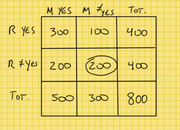
A. 1/4
B. 3/8
C. 1/2
D. 5/8
E. 3/4
The Official explanation was a bit cumbersome. Anyone want to showcase a streamlined approach to tackling this one?

Woah hold on there Rich![email protected] wrote:
Notice the Grand Total (800 students) is in the lower-right box and the 200 who said "YES to JUST M" is the left column/middle box. The rest of the data can be transferred from the original table and/or calculated.
The answer to this question is the middle box.
Two conditions that fulfill the multiple of 8 solution[email protected] wrote:Hi fourteenstix,
It's normally best to list just 1 question per post, but I'll answer both questions here:
First, the probability question. This question has LOTS of details that you have notice if you're going to answer it correctly. You'll notice that the answers have 8 as a common denominator (this provides an interesting hint to how the "math" will work. You should also notice that the question stem asks you to consider the numbers from 1 to 96, inclusive (and it's interesting that 96 is a multiple of 8...).
The prompt asks you to think about (n)(n+1)(n+2), so you'll be dealing with 3 consecutive integers multiplied together. For a number to be divisible by 8, it must include at least three 2's when the number is broken down using prime factorization:
For example: (1)(2)(3) = 6 which is NOT divisible by 8 (obviously), but you'll notice that there's just ONE 2.
For example: (2)(3)(4) = 24 which IS divisible by 8; you'll notice that there ARE THREE 2s (the 2 has one and the 4 has two).
So, we're looking for all the options that have three 2s in them...
Any option that is (even)(odd)(even) will include three 2s
Any option that has (odd)(multiple of 8)(odd) will also include three 2s
If you consider the first 8 possibilities
(1)(2)(3) = NO
(2)(3)(4) = YES
(3)(4)(5) = NO
(4)(5)(6) = YES
(5)(6)(7) = NO
(6)(7)(8) = YES
(7)(8)(9) = YES
(8)(9)(10) = YES
5/8 are what we're looking for. This pattern continues through every "set of 8", so the final answer is D
GMAT assassins aren't born, they're made,
Rich